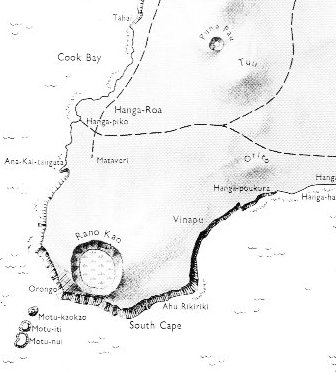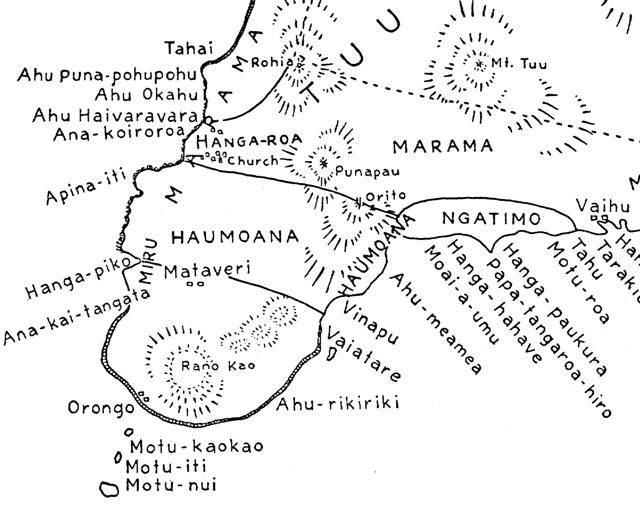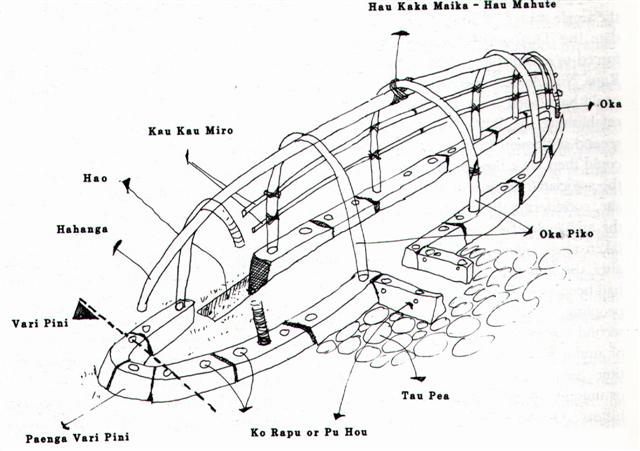4. The kuhane of Hau Maka ended her
series of defined stations with Ahu Akapu and left the
remaining part of the island to the west of Puna Pau and Rano Kau
unmentioned:

On the other hand, when Ira had entrusted Makoi the task of
naming places he made a circuit moving clockwise and began not
with the 3 islets outside Rano Kau but with Apina
Iti, the rounded peninsula south of Hanga-Roa. We can
find the name on the map
of Métraux:

Manuscript E has 2 versions of the circuit of names
given by Makoi. The first version has numbered items and it
has ko te pipi horeko a morokiroki as number 35. Pipi means both the rump (the rear)
and the sprout (the beginning) of something, and hore defines
more explicitly how the rear is cut short:
|
Pipi
1. Bud, sprout; to bud, to sprout;
ku-pipi-á te tumu miro tahiti, the trunk of the
miro tahiti has sprouted. 2. A small shellfish,
common on the coast.
1. To blanch, to etiolate. 2. A spark,
to sparkle. 3. Young branches, shoot, sprout, to bud.
Mq.: pipi, tip of the banana blossom. 4. Snail,
T, pea, bean. P Mgv.: pipi, small shellfish in
the shape of a mussel. Mq.: pipi, generic term
for shells. Ta.: pipi, generic term for beans. 5.
To boil with hot stones. 6. A wave. 7. Thorn, spiny,
uneven. 8. Small; haha pipi, small mouth. 9.
Rump, the rear. Pipine, to be wavy, to undulate.
|
| Hore
(Hore, horehore): to cut
with a knife or with an obsidian blade (also: horea).
Horeko, solitary, lonely; kona horeko,
solitary place, loneliness.
To hew, to cut off, to amputate, to
castrate, to cut with a knife, to decapitate, to abridge, to
incise, to set landmarks; a notch, incision, tenon; hore
poto, to cut short off; hore te gao,
to chop the
head off. |
Number 35 at Te Pipi Horeko seems to fit well, because we can compare with number 24 (counted from Te
Pu Mahore) on the kuhane list, viz. Oromanga. The
explorers spent 27 days outside the 'cave' of Kuukuu before
they invented the pipi horeko solution to their dilemma.
Number 27 is one less than 28 (= 4 * 7) and 35 is one less than 36
(= 4 * 9), and Ahu Akapu (27) is apparently similar in
meaning to Te Pipi Horeko (35).
In our primary text example the final glyph is
number 35 in the line:
 |
 |
 |
 |
 |
 |
 |
|
Eb7-17 |
Eb7-18 |
Eb7-19 |
Eb7-20 |
Eb7-21 |
Eb7-22 |
Eb7-23 |
 |
 |
 |
 |
 |
 |
 |
|
Eb7-24 |
Eb7-25 |
Eb7-26 |
Eb7-27 |
Eb7-28 |
Eb7-29 |
Eb7-30 |
 |
 |
 |
 |
 |
|
Eb7-31 |
Eb7-32 |
Eb7-33 |
Eb7-34 |
Eb7-35 (581) |
The thumb is here converted into a
'fruit' (hua), i.e. into a new generation, and
Tauono could be alluded to by the 6 'feathers'
around the hua sign. A complete cycle could be
hinted at by number 581. E.g. could we reduce by 326
(the number of glyphs on side a) and 581 - 326 = 255 =
1 less than 256 (which is equal to 16 * 16). Most
obvious, though, is 73 * 5 = 365.
35 (= 13 + 22) could be the number of holes intended
to be counted in our hare paega map:

The entrance itself could refer to the entrance to a
new year, announced by the return of Matariki in the
night sky:
... In Hawaii, the
rising of the Pleiades was the signal for the beginning of the
Makahiki major harvest festival which centered upon Lono
(Rongo). For Rapa Nui, as for the Maori, the
Mangarevans and the rest of the people of the Southern Hemisphere,
the rising of the Pleiades is almost simultaneous with the Austral
June solstice ... The word morokiroki
could allude to the prophetic vision (uruga) of
Rega Varevare a Te Niu. Instead of
mo-kirokiro, getting dark, mo-rokiroki could mean the
opposite, i.e. getting light:
|
Uru Uru.
1. To lavish food on those who have contributed to the
funerary banquet (umu pâpaku) for a family member
(said of the host, hoa pâpaku). 2. To remove the
stones which have been heated in the umu, put meat,
sweet potatoes, etc., on top of the embers, and cover it
with those same stones while red-hot. 3. The wooden tongs
used for handling the red-hot stones of the umu. 4.
To enter into (kiroto ki or just ki), e.g.
he-uru kiroto ki te hare, he-uru ki te hare. 5. To get
dressed: kahu uru.
Ta.: uru, the human skull. Mq.:
uu, the head. Sa.: ulu, id. Moriori: ulu,
id. Uru, make even.
1. To enter, to penetrate, to thread, to
come into port (huru); uru noa, to
enter deep. Hakauru, to thread, to inclose, to admit,
to drive in, to graft, to introduce, penetrate, to
vaccinate, to recruit. Akauru, to calk. Hakahuru,
to set a tenon into the mortise, to dowel. Hakauruuru,
to interlace; hakauruuru mai te vae, to hurry to. 2.
To clothe, to dress, to put on shoes, a crown. Hakauru,
to put on shoes, to crown, to bend sails, a ring. 3.
Festival, to feast. 4. To spread out the stones of an oven.
Uruuru, to expand a green basket. 5. Manu uru,
kite.
Uru manu.
Those who do not belong to the Miru tribe and who,
for that reason, are held in lesser esteem.
Úru-úru. To catch
small fish to use as bait.
Uru-uru-hoa. Intruder, freeloader
(person who enters someone else's house and eats food
reserved for another).
Uruga (uru
1). Entrance. Uruga.
Prophetic vision. It is said that, not long before the first
missionaries' coming a certain Rega Varevare a Te Niu
saw their arrival in a vision and travelled all over the
island to tell it: He-oho-mai ko Rega Varevare a Te Niu
mai Poike, he mimiro i te po ka-variró te kaiga he-kî i
taana uruga, he ragi: 'E-tomo te haûti i Tarakiu, e-tomo te
poepoe hiku regorego, e-tomo te îka ariga koreva, e-tomo te
poporo haha, e-kiu te Atua i te ragi'. I te otea o te rua
raá he-tu'u-hakaou ki Poike; i te ahi
mo-kirokiro he-mate. Rega Varevare, son of Te
Niu, came from Poike, and toured the island
proclaiming his vision: 'A wooden house will arrive at
Tarakiu (near Vaihú), a barge will arrive,
animals will arrive with the faces of eels (i.e. horses),
golden thistles will come, and the Lord will be heard in
heaven'. The next morning he arrived back in Poike,
and in the evening when it was getting
dark, he died. |
Pipi is to boil with hot stones.Uru is to remove the
stones which have been heated in the umu, or to put meat,
sweet potatoes, etc., on top of the embers, and to cover it with those
same stones while red-hot. Stones are used together with fire in
order to cook. The earth oven (umu) will cook, heat up, that
which will be uncovered, 'born from the oven'.
To die is to become cold, to be born is to 'come out hot from the
oven'.
Although roki means a sleeeping-place its
double (roki-roki) could mean the opposite:
| Roki
Pau.: roki, a bed. Mgv.: roki, bed,
sleeping-place. Ta.: roi, bed. Mq.: oki, sleeping-place.
Sa.: lo'i, pigsty. |
A negation of kai is similarly expressed
by kai-kai (the string games). Kai (eating) refers
to the season when Sun is present and the strings (kaikai)
will hamper Sun, catch him and ultimately cover him (by the dark
cloth woven from strings).
Kuukuu is evidently strangled by strings,
according to how Metoro interpreted Aa1-11:
 |
 |
 |
 |
|
Aa1-1 |
Aa1-2 |
Aa1-3 |
Aa1-4 |
|
tagata ui |
ki
tona marama |
e
tagata noho ana - i te ragi |
te
tagata - hakamaroa ana i te ragi |
 |
 |
 |
 |
|
Aa1-5 |
Aa1-6 |
Aa1-7 |
Aa1-8 |
| ko
te moa |
e
noho ana ki te moa |
e
moa te erueru |
e
moa te kapakapa |
 |
 |
 |
 |
|
Aa1-9 |
Aa1-10 |
Aa1-11 |
Aa1-12 |
| e
moa te herehua |
ka
hora ka tetea |
ihe
kuukuu ma te maro |
ki
te henua |
Presumably the 4 figures in the center represent
the 4 pillars which keep the sky roof high. Metoro mentioned
Kuukuu only at Aa1-11, never anywhere else while reading the
rongorongo
tablets for Bishop Jaussen. We have earlier found
a parallel between the 6 glyphs including Aa8-26 (the cut off viri) and
the 6 glyphs including atua mata viri:
 |
 |
 |
 |
 |
 |
| Aa8-25 |
Aa8-26 |
Aa8-27 |
Aa8-28 |
Aa8-29 |
Aa8-30 |
 |
 |
 |
 |
 |
 |
|
Eb7-11 |
Eb7-12 |
Eb7-13 |
Eb7-14 |
Eb7-15 |
Eb7-16 |
A new fire comes beyond the dark Saturn. The 11th kuhane
station is Roto Iri Are, and roto means inside (as when Kuukuu was
put in a 'cave').
|










